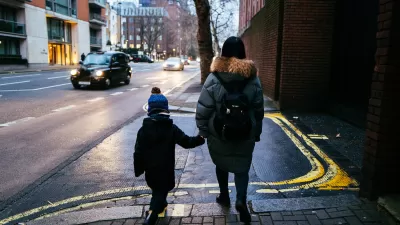Are suburbanites less fearful of crime than city-dwellers? Maybe not.

In some ways, suburbia has clearly given its residents the benefits they hoped for: newer housing with more space, cheaper housing than in the most fashionable city neighborhoods, and "better" (that is, more racially and economically segregated) schools. In addition, it could be argued that suburbs are safer than most city neighborhoods.*
But this is not to say that suburbs have lived up to their promise. I was recently skimming a book on suburbanization** and noticed the following statement by someone who moved from Buffalo to one of its suburbs: "I just want my kids to be safe ... [in the suburbs] I can send my kids to the store and be confident they won't be approached by anyone." But can you really "send your kids to the store" in suburbia?
Not until they can drive. Even if your children (unlike most suburbanites) live within walking or biking distance of a store, there seems to be a norm in suburbs and small towns against children (or even teenagers) being on their own. In suburban Atlanta, I rarely saw anyone too young to drive outdoors (unless they are in a parking lot on the way to or from their parents' car).
In fact, this norm is actually supported by public officials who consider children on foot to be evidence of child endangerment by their parents. I subscribe to the Free Range Kids blog, which contains numerous stories of parents and children being harassed for allowing their children to walk. For example, one six-year-old who was allowed to walk to the post office was herself detained by the police, and Child Protective Services sought to remove the child from her parents. Even older children or those who visit indoor attractions are not safe from official paranoia. In Montana, a parent who dropped two twelve-year olds off at a local mall was arrested for child endangerment, and pled guilty in order to avoid further difficulties.
Are cities any better? To be fair, I don't see a lot of children in midtown Manhattan where I live. But when I visit child-heavy city neighborhoods such as Williamsburg and Kew Garden Hills, I see children walking around, seemingly on their own. Similarly, in Toronto, children ride city buses to and from school.
What went wrong? Why did suburbia fail to live up to its promise of free-range children? One major factor is television news. American suburbanites (as well as their counterparts in other English speaking countries) have been exposed to television's obsession with "stranger danger"—the fear that one's children may be molested by a stranger. Dramatic crimes get high television ratings, so television gives such crimes lots of coverage, thus causing parents to overestimate their frequency. So parents influenced by television may be more likely to shut away their children- despite the fact that children are 2.5 times more likely to drown in a swimming pool, and 26 times more likely to die in a car crash, than to be abducted by a stranger.***
But I think there is another difference that goes to the heart of the suburban experiment. Where most adults don't walk, it is unusual to see a child walking. And where it is unusual to see a child walking, the whole idea becomes suspect. By contrast, where adults walk themselves, they are more willing to give children leeway to do the same.
None of this means, however, that suburbs cannot become child-friendly places. It seems to me that new urbanism is in part an attempt to restore walkability to suburbs- and if adults walk themselves, they will be less surprised (and horrified) to see children walk.
*Certainly, the average suburban neighborhood has less crime than the average city neighborhood. However, this benefit may be partially outweighed by increased risk of car crashes and obesity.
**Places of their Own, by Andrew Wiese (pp. 266-67)
*** See this article at footnote 89.

Maui's Vacation Rental Debate Turns Ugly
Verbal attacks, misinformation campaigns and fistfights plague a high-stakes debate to convert thousands of vacation rentals into long-term housing.

Planetizen Federal Action Tracker
A weekly monitor of how Trump’s orders and actions are impacting planners and planning in America.

San Francisco Suspends Traffic Calming Amidst Record Deaths
Citing “a challenging fiscal landscape,” the city will cease the program on the heels of 42 traffic deaths, including 24 pedestrians.

Defunct Pittsburgh Power Plant to Become Residential Tower
A decommissioned steam heat plant will be redeveloped into almost 100 affordable housing units.

Trump Prompts Restructuring of Transportation Research Board in “Unprecedented Overreach”
The TRB has eliminated more than half of its committees including those focused on climate, equity, and cities.

Amtrak Rolls Out New Orleans to Alabama “Mardi Gras” Train
The new service will operate morning and evening departures between Mobile and New Orleans.
Urban Design for Planners 1: Software Tools
This six-course series explores essential urban design concepts using open source software and equips planners with the tools they need to participate fully in the urban design process.
Planning for Universal Design
Learn the tools for implementing Universal Design in planning regulations.
Heyer Gruel & Associates PA
JM Goldson LLC
Custer County Colorado
City of Camden Redevelopment Agency
City of Astoria
Transportation Research & Education Center (TREC) at Portland State University
Jefferson Parish Government
Camden Redevelopment Agency
City of Claremont






























